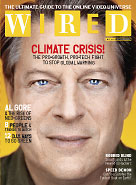This month’s issue of Wired is jammed pack with information pertaining to the next Green Revolution, and ‘tech meets nature’ topics such as: sustainable business, our looming environmental crisis, eco-friendly products, eco-chic lifestyles, and a feature article on the resurrection of Al Gore. To me, all of this talk is old hat. To be perfectly frank, I was beginning to feel as though the neo-eco mindset would never catch on. All of this discussion in a magazine as cool as Wired sheds new hope on the Green movement.
To me, all of this talk is old hat. To be perfectly frank, I was beginning to feel as though the neo-eco mindset would never catch on. All of this discussion in a magazine as cool as Wired sheds new hope on the Green movement.
I once took an Environmental History course as an undergrad that turned out to be one of the most inspirational classes I have ever taken. The class turned me on to authors such as Edward Abbey, Carolyn Merchant, Aldo Leopold, Rachel Carson, Teddy Roosevelt, etc. The semester experience and discussion of relevant topics fueled me to adopt a ‘Voluntary Simplicity’ mentality and lifestyle that I have held on to ever since. For me, it clicked… and the point is…I just thought it was cool, so I adopted it as part of my identity.
All of this talk of conservation and simplification is nothing new. We all know this. I have often pondered: “What would it take to make it stick in the mainstream?”
In the article, ‘Rise of the Neo Greens,’ Daniel H. Pink quotes Ken Kurani on consumer motivation to purchase hybrid vehicles:
“Lower resource consumption is part of an identity people are constructing. They want to be seen as someone who’s concerned about the world around them. At the same time, they want others to see that they’ve done this, so that others might see themselves doing this.”
In other words, it is more about style, being hip, and being seen being hip. Like it or not, this is a very big part of the Neo-Eco mindset. I would also venture to guess that this was a very big part of the first Green Revolution. Yet, the first time around there was something missing: mass appeal.
I feel this may be the Green Movement’s only hope in creating a Tipping Point. For those of you familiar with Malcolm Gladwell’s salesman-connector-maven triad, the first order of business must be: To be green must be hip to the masses.
Caroline Schoeder Some people change when they see the light, others when they feel the heat.
Unfortunately, it will take something extremely powerful to encourage people to change before it is absolutely necessary.
So what does this have to do with a neo-Green Aesthetic?
Before something is hip, it has to appeal to people visually. My experience in education, culinary arts, business, and the music industry has taught me that people are influenced greatly by what they see more than any other sense. To be successul in any field, one needs to pay very close attention to visual details. In education, we say students have a visual learning style, and we arrange classrooms to ensure sucessful learning outcomes. In the culinary arts, your customers’ first impression is the presentation of the food. Extremely important, yet so often overlooked. In any professional field, we talk of ‘Dressing for Success.’ In the music industry, we pay close attention to lighting, dressing to fit the part, and providing a visual experience for the audience. Perhaps far more than we realize, people are controlled by what they see.
Yet, all that being said, people also yearn for authenticity.
This creates a very interesting environment for a movement, a tipping point, a revolution, whatever it is you’d like to call it.
Do you suppose the answer is a fusion of clean, minimilist visuals such as represented by Apple, web 2.0 design, Toyota, Samsung, even Sony with the green aesthetic trend setters such as Whole Foods, Sun microsytems’ new eco-friendly line of servers, and Patagonia?
Are you seeing/experiencing the fusion/overlap of these aesthetics in your daily consumer/producer/professional decision making? Are you being influenced by this type of powerful imagery? I know I am, and I am consisitently seeing others being influenced as well.
So what killed the authentic, natural aesthetic the first time around? Ask a baby boomer…many will tell you that at one time it was hip to be green. So what happened?
the awful 80’s aesthetic – it even ruined the authentic beauty of Neil Young. Have you ever watched ‘Live In Berlin’ from 1986? Please don’t. It’s horribly painful to see Neil in parachute pants and a wireless headset.
The dirty hippy aesthetic: As fun as it is to be free and uninhibited, no one wants to hang with the guy who reaks of body oder, and is dressed in a burlap sack…And who is going to take him seriously? Take a look at home-grown websites: Let’s compare: Sun Organic to Wild Oats. One must not negelct the power of visual imagery when creating materials that promote the authenticity of your business/yourself etc. In this day and age, it is a recipe to not be taken seriously.
I’m sensing that this neo-Green aesthetic is a much more powerful one; One that has much more potential to appeal to the masses. It is going to be interesting to continue watching it evolve.
By the way, did you know Walmart sells organic food? They have been for quite sometime. I am now of course being the facetious devil’s advocate. There will always be those that take something remarkable and taint it, but to me the fact that the Global Corporation is selling organic food is a significant indicator of a change in consumer behavior.
How can you, your business, and your business community benefit from supporting this movement? It is something to think about.